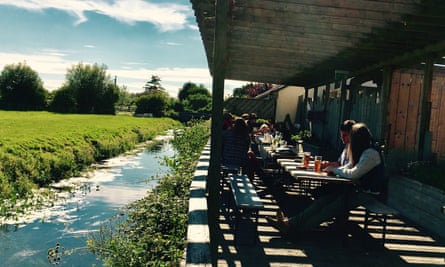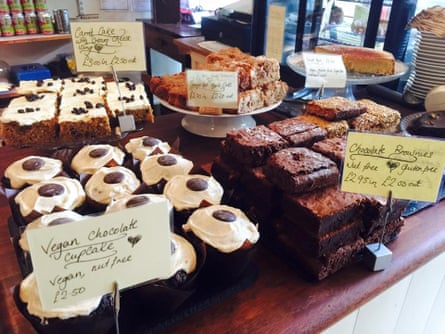‘Summer here is something to behold,” says Kevin Mitchell from behind the counter of Knight’s, his chippy on Glastonbury’s Northload Street. “Hippies, druids, goddesses in their finery, people dressed as elves: you never know who – or what – is going to walk through the door.”
The Guardian’s product and service reviews are independent and are in no way influenced by any advertiser or commercial initiative. We will earn a commission from the retailer if you buy something through an affiliate link. Learn more.
Knight’s has been run by the same family on the same site since 1909, although the building itself is medieval, constructed from stone taken from Glastonbury Abbey after it was sacked by Henry VIII. If that stone could talk, it would tell of a town much changed from its roots as a place of Christian pilgrimage to its present reality as the new-age capital of England.
The druid groups are always falling out with each other. It’s all a bit People’s Front of Judea
That transformation doubtless has much to do with the establishment in 1970 of the Glastonbury festival, seven miles to the east of Glastonbury proper. In a typical June, 135,000 music fans will spend the weekend at Michael Eavis’s farm near the village of Pilton. But Glastonbury’s 9,000 full-time inhabitants represent more than 70 faith groups, and the town has forged a resilient identity of its own.
“Some people would dearly love Glastonbury to have stayed the old market town of 50 years ago,” says Mitchell, “but we have survived by embracing the multicultural, multi-faith society. So long as they eat fish and chips, I don’t care.”
This being one of the so-called “fallow” years in which the festival has a break to allow the land to recover, it seems a good opportunity to focus on the town from which it takes its name. So what is Glastonbury like without Glasto?

To find out, I visit on May Day. This is the gleaming hinge of the Glastonbury year, celebrated as Beltane by the town’s many pagans. On this day, the character of the place is the same as always – small-town mundanity rubbing up against exuberant weirdness – but a little more intense. Put it this way: in a Glastonbury cafe you’re never far from someone in a mistletoe crown eating a full English, but on May Day they might add an extra sausage.
It’s a full moon, and the early-morning drive over the Somerset Levels reveals a daguerreotype landscape in silver light. I can just make out the dark mass of my destination: Glastonbury Tor, the steep hill topped by a 15th-century tower that stands as a symbol of the town. For each of the last 30 years, 1 May has been marked by a druidic ceremony on the summit.
“The druids are always falling out with each other,” I had been warned by Vicki Steward, who writes Normal For Glastonbury, a blog that takes an affectionate view of the town’s Monty Pythonesque qualities. “There are various druid groups including the OBOD (Order of Bards, Ovates and Druids) the BDO (British Druid Order), GOD (Glastonbury Order of Druids); and then there are the Loyal Arthurian Warband. It’s all a bit People’s Front of Judea.”

In fact, the occasion is remarkably collegiate: pipers, folk singers, morris dancers, all welcoming the dawn in their own way. The view is so stunning as to be unphotographable; even one’s eyes aren’t quite up to the job.
Rollo Maughfling, archdruid of Britain, leads the ceremony, calling for peace at all points of the compass, the light climbing little by little to reveal his white robe, red cloak, white beard and, finally, cricket umpire-ish hat. He blows a brass hunting horn in fanfare to the risen sun.
By 7am, it is shining golden down the High Street. Glastonbury has few chain stores; instead independent shops with colourful fronts give the impression that little has changed since yesteryear, until one looks closer at the displays – healing crystals, wands and cauldrons, incense, tarot cards, and accessories “for the discerning witch”. On Church Lane, an American visitor peers at a pair of stuffed magpies in the window of a shop offering “ethically sourced taxidermy” and declares that it reminds her of the “vegan lapdancing club” back home in Portland, Oregon.
It’s very difficult to buy an ordinary pair of trousers. But you can go to the neighbouring village for that
Glastonbury is the antithesis of a clone town, which comes with its own challenges. “It’s actually very difficult to buy an ordinary pair of trousers,” says Jamie George, co-owner of Gothic Image, which was, back in 1979, the first “alternative” shop here. “But you can go to the neighbouring village for that.”
Outside the Lazy Gecko Cafe, a busker is singing a song from the 13th century: “Summer is icumen in …” A woman with plums in her vowels and flowers in her hair tells a new acquaintance, “Find me on Insta, dah-ling …” There is a strong sense of the centuries swirling together. There is something in the air, and not the obvious. Though Glastonbury seems to run on mead and weed, its hedonism feels rooted in something authentically numinous.

One can sense this quality at the abbey. It has that mingled sadness and peace often found in ruined churches. A white dove flies through Romanesque arches, and nothing now remains of the high altar but a stone border within which irreverent dandelions refuse to bow their heads. Yet what still stands is grand and beautiful. “For a thousand years Glastonbury was the most spectacular abbey in Christendom,” says Jon Cousins, the town’s former mayor. “It was so important that in Italy they called it Roma Secunda, the Second Rome. God knows why Geoffrey Chaucer wrote about that other place.”
Like many who visit and settle in Glastonbury, Cousins felt “called” there. You hear this a lot: that the town and landscape has some sort of siren presence. To help this sort of visitor, the tourist information office features a “pilgrim reception centre”, which directs “spiritual seekers” to whatever they might need, be it a Christian shrine or a Wiccan ritual. “Someone might stagger in here and say they’ve just seen Archangel Michael on the Tor,” says the centre’s founder, Morgana West. “Glastonbury has an effect on people. But we are non-judgmental.”
Back out on Magdalene Street, the 376 bus to Bristol is being held up by a maypole in the road. “Blessings be for public transport,” calls a man with a green face and top hat, soothingly, to the driver. This is the Beltane procession through town.

There are hundreds following, among them the Reverend Diana Greenfield, AKA “the goth vicar”, whose dog collar peeps over an elaborate mantle of leather and fur. This servant of the Church of England is strolling companionably alongside Tracy, a woman in full paganish fig – an antlered headdress wound around with ivy. Tracy is walking Oakley, a wirehaired vizsla; the Rev has her own pet, Cara the collie, on a lead. It’s a very Glastonbury, very British scene, the bonds of dog ownership being more important than differences in faith.
We all climb the hill to Bushy Coombe, a green field overlooking the town. There, amid drumming and ululation, the maypole is erected. Green ribbons shimmer as people dance around. Some wag mentions the Wicker Man, of course, but that’s not quite right. Today feels more like a celebration of the community and its twin values: open mind and open heart.
At around 3pm, as the last ribbon tightens around the pole, the sun disappears behind a bank of cloud and a gentle drizzle begins to fall. The ritual, it appears, has worked – dull and damp, the English summer truly is icumen in.
Where to stay

The Sheppey Inn is a well-regarded pub and restaurant with three en-suite rooms (£100-£120 a night) and two nearby cottages (£130 and £140 a night). Out in the wilds of the Somerset Levels, four miles from Glastonbury, it offers welcome perspective on the town. The bar, decorated with vintage toys and stuffed animals, carries an enticing selection of cocktails and local scrumpy. “We’ve tried to create a place that is true to where it is,” says owner Mark Hey, “so it feels like a giant cider barn full of weirdness.”
Where to eat and drink

Hundred Monkeys is an organic cafe and bakery that does a mean veggie breakfast. The Rainbows End was Glastonbury’s first vegetarian cafe; over the decades it has managed to perfect the vegan chocolate brownie. The George and Pilgrims’ is about as old as English inns get, slaking thirsts when the abbey was still a going concern, and should satisfy connoisseurs of low beams, nooks and crannies. Alternatively, the King Arthur has the town’s biggest beer garden, a sun trap full of dogs, kids and dudes with dreadlocks.

Comments (…)
Sign in or create your Guardian account to join the discussion